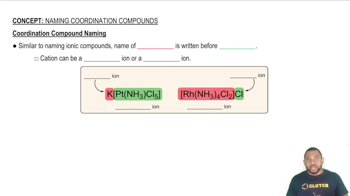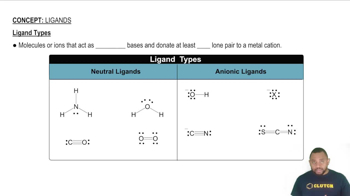Here are the essential concepts you must grasp in order to answer the question correctly.
Coordination Compounds
Coordination compounds consist of a central metal atom or ion bonded to surrounding molecules or ions called ligands. The nature of these bonds and the arrangement of ligands around the metal center are crucial for determining the compound's properties and reactivity. Understanding the structure and nomenclature of these compounds is essential for systematic naming.
Recommended video:
Coordination Compound Naming
Ligands and Their Types
Ligands are ions or molecules that donate electron pairs to the central metal atom in a coordination compound. They can be classified as monodentate (binding through one atom), bidentate (binding through two atoms), or polydentate (binding through multiple atoms). Identifying the type and number of ligands is vital for correctly naming coordination compounds.
Recommended video:
Nomenclature of Coordination Compounds
The nomenclature of coordination compounds follows specific rules set by the International Union of Pure and Applied Chemistry (IUPAC). This includes naming the ligands first, followed by the metal, and indicating oxidation states. The systematic name reflects the composition and structure of the compound, which is essential for clear communication in chemistry.
Recommended video:
Coordination Compound Naming

 Verified step by step guidance
Verified step by step guidance


